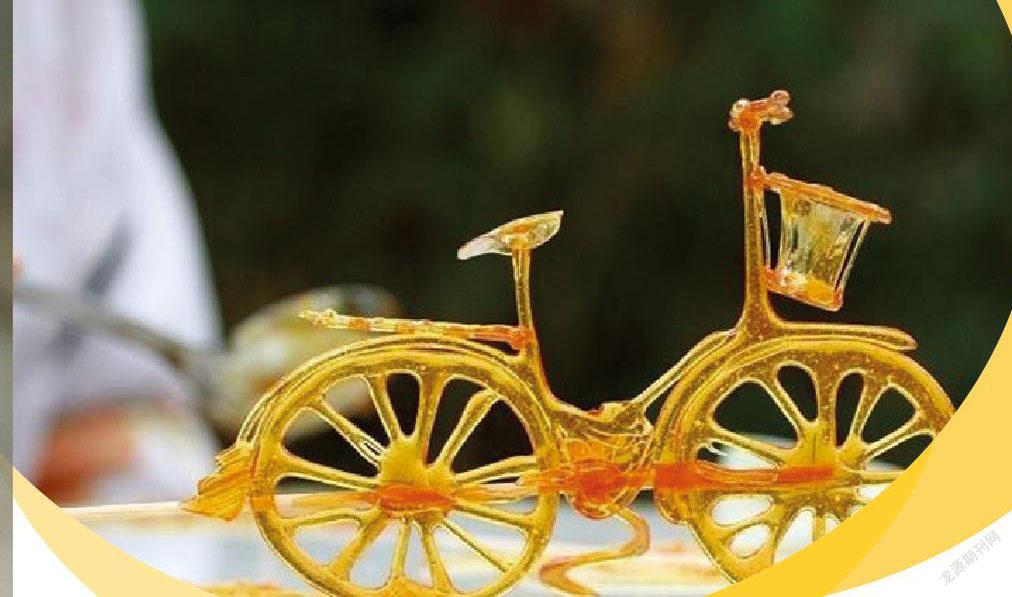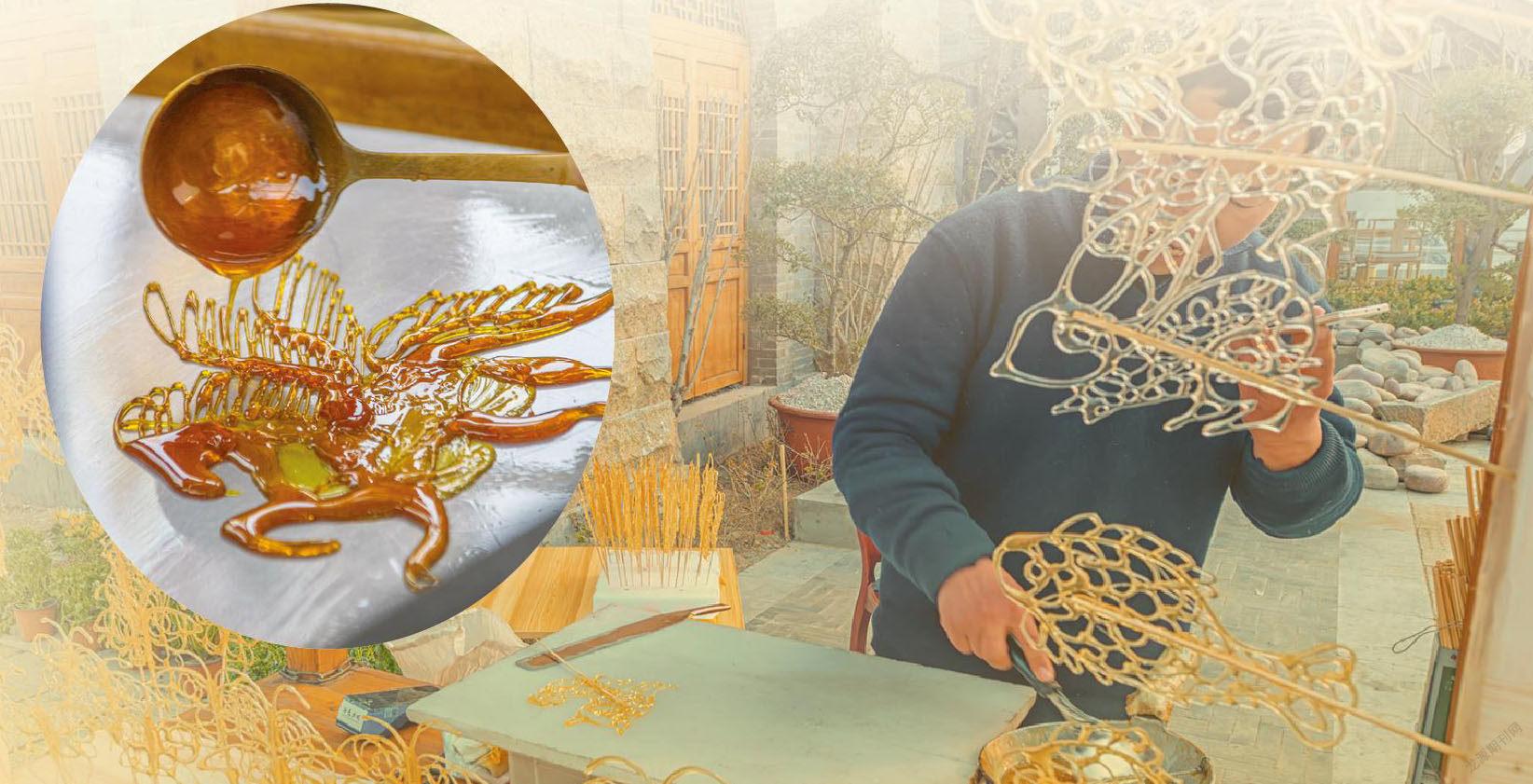TRADITIONAL CHINESE FOLK ART: SUGAR PAINTING 中国传统民间艺术——糖画
2021-01-21Juno
Juno



你吃過糖画吗?糖画,顾名思义,就是以糖做成的画,它亦糖亦画,可观可食。糖画是集民间工艺美术与美食于一体的独特的传统手工技艺,被列入中国国家级第二批非物质文化遗产名录。
Have you tasted one snack as well as the traditional Chinese form of art known as sugar painting?
Sugar painting can be found in various areas of China, but is 1)typically found around the Sichuan Province of southwestern China along the streets or in the parks.
The artists normally sit before a wooden 2)stand where there is a 3)poilshed 4)slab of marble in the middle. On the side there is a wooden plate with a 5)revolvable bamboo 6)arrow on it. The plate is painted with various patterns in a circle such as a dragon, bird, dog, flower basket and so forth. After paying, the
1) typically [?t?p?kli] adv.典型地
2) stand [st?nd] n.架,台
3) polished [?p?l??t] adj.光滑的,擦亮的
4) slab [sl?b] n.厚板,平板
5) revolvable [r?'v?lv?bl] adj.可旋转的
6) arrow [??r??] n.箭头
customer, normally kids, turn the arrow and wait till it stops. The pattern pointed by the arrow is the one the artist is supposed to make with sugar.
Sugar painting is very different from normal painting and was 7)originated from the Ming Dynasty when sugar animals and figures were made in 8)molds as part of a sacrifice in religious rituals. In the Qing Dynasty, sugar painting gained more popularity. At that time, many people made a living by sugar painting, shouldering a carrying pole and setting up 9)stalls in crowded streets, in front of theatres and busy public places.
There are two main categories: plane painting and 10)solid painting. For the plane painting (which is the easier one), the painter uses the brown sugar or white sugar as the raw material, the bronze spoon and a 11)shovel as the tool, and the slab of marble as the “paper”. To acquire liquid sugar, the artist has to cook the solid sugar in a pot before painting. Since the hot liquid sugar could freeze solid if it cools, the artist has to produce his work very quickly.
Using a small spoon to 12)scoop the 13)syrup which looks like silk and thread, the handi-craftsman concentrates his strength on the wrist and takes the spoon as a brush pen, rising and pausing 14)strokes, up and down, left and right. Soon a sugar painting of an animal, flower or a bike is finished, and the painter separates the painting from the marble with a shovel, puts a bamboo slice on the painting or wraps it with a 15)transparent plastic bag.
Although the number of sugar painters has decreased, due to its unique charm, a certain number of artists are making sustained efforts to preserve it by offering classes,
7) originate [??r?d??ne?t] v.起源于
8) mold [m??ld] n.模子
9) stall [st??l] n.小摊
10) solid [?s?l?d] adj.固体的;立体的
11) shovel [???vl] n.铲子
12) scoop [sku?p] v.铲
13) syrup [?s?r?p] n.糖浆
14) stroke [str??k] n.笔画
15) transparent [tr?ns?pε?r?nt] adj.透明的
holding relevant activities such as sugar painting contests.
Nowadays, sugar painting has already beenlisted as National Non-Material Culture Heritage.
你尝过糖画吗?它是一种小吃,同时也是一种中国传统艺术形式。
糖画在中国各地随处可见,尤其是在中国西南部的四川省的城市街头或公园。
糖画师们通常坐在木架前,中间有一块光滑的大理石板。一侧有一个木转盘,上面有一个可旋转的竹箭。转盘上画着龙、鸟、狗、花篮等各种图案,以圆形排列。支付后,顾客——通常是孩子,他们会转动箭头,等待,直到它停止。箭头指向的图案便是糖画师用糖画出的图案。
糖画与普通绘画大不相同,它起源于明代,当时用糖制成的动物和人物是作为宗教仪式祭品的一部分,是用模具制作的。到了清代,糖画越来越受欢迎。当时,许多人靠糖画为生,肩扛一根长杆,在拥挤的街道、剧院和繁忙的公共场所摆摊。
糖画主要有两类:平面糖画和立体糖画。对于平面糖画(这是相对比较容易的),糖画师以红糖或白糖作为原料,青铜勺和铲子作为工具,大理石板作为“纸”。为了获得液态糖,糖画师在绘画前必须把固体糖煮在锅里。因为热的液体糖如果冷却,可能会冻结成固体,糖画师必须非常迅速地制作他的作品。
用一个小勺子铲糖浆,看起来像丝绸和线,糖画师把力气集中在手腕上,并用勺子作为一支笔刷,上升和暂停笔触,向上和向下,向左和向右。不久,动物、花或自行车的糖画就完成了,糖画师用铲子将画与大理石分开,在画上放一根竹片,或者用透明塑料袋包起来。
虽然糖画师的数量在减少,但是由于糖画独特的魅力,很多艺术家正在作出持续的努力,如进行糖画教学、举行糖画比赛等相关的活动。
如今,糖畫已被列为国家级非物质文化遗产。
